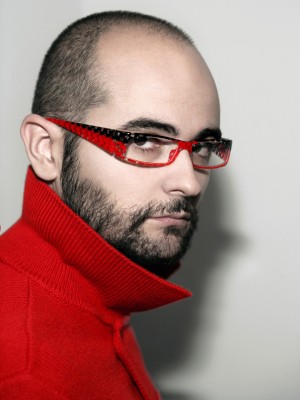The Beauty Within: Interview with Photographer Paco Peregrín
GALO: I read somewhere that you said that the concept behind Beautiful Monsters is the reflection on one’s identity and the mask many of us wear through our clothing and makeup. Could you explain this further?
PP: All photos that integrate Beautiful Monsters allude to a very particular concept of beauty (sometimes unusual, alien, or even beautifully monstrous), to its ephemeral nature and the passage of time. Naked men and women are on a neutral background where makeup becomes of great prominence, even avoiding the recognition of the models, thus reflecting on the idea of identity and a proposal for the makeup as a contemporary mask that protects us — on the one hand like a camouflage and the other helping us to build a super-ego.
GALO: I must say, when I first heard the title Beautiful Monster, I immediately thought of Lady Gaga and her fandom. When you were thinking of the title for this exhibit, did you envision this association, or were you conceptualizing something entirely different?
PP: The title of my series is independent to the Lady Gaga phenomenon and involves a more complex concept, but somehow we have several characteristics in common because we advocate a different way of understanding the beauty, where the differences make each person unique.
GALO: How many photographs are there in the series and how long did it take you to complete it?
PP: I spent one year preparing the 20 photos that I showed at the Isabel Ignacio Art Gallery in Seville, but the Beautiful Monster series is still open.
GALO: How did you go about choosing models for this series? Did you have any requirements that differ majorly from your other shoots?
PP: The casting is essential for me because it is very important that the model inspires the photographer according to the concept of the story. In general, and even more so in this case, I prefer models with personality and peculiar features to commercial models with a boring, perfect beauty.
GALO: Is there a certain image that summarizes the entire exhibit as a whole?
PP: A few of them are very significant, but each photograph is special because I use different symbolic elements in each one to express the passage of time or the ephemeral nature of beauty.
GALO: Your photographs frequently make a strong fashion statement that can often stand against numerous runway shows and fashion shoots. What do you think of the world of fashion today?
PP: I like it. But I think the personality and the style must be above the trends. I think that fashion, art and photography, create a feedback loop and they are the crux of the contemporary visual representation. Fashion photography is more than just a medium to sell clothes, it synthesizes the aspirations and tastes of an era and gives to fashion an eternal character. Nowadays clothing is often just a pretext for some form of artistic photography.
GALO: Do you ever have clothing designed specifically for your shoots and models?
PP: Yes, sometimes I had the collaboration of stylists and designers who have created pieces exclusively for my shootings.
GALO: As a photographer you yourself are out of the spotlight, yet despite this factor you are renowned in the world of fashion and photography. Do you often feel that you are hiding behind your camera?
PP: Absolutely. I like to be recognized among the professionals but I do not think it’s fun to be very popular. I am a shy person who has learned to be outspoken over the years. Working at various theater groups helped me to overcome my shyness in my teens and discover the world of expression through art. I also worked in front of the camera and I found the experience exciting and fun. That has helped me to work with models and face a photo-shoot better, but I prefer to work behind the camera to create images. It allows me to express myself without having to directly expose [who I am].
GALO: What strategies do you use to make people feel comfortable in front of the camera?
PP: Before I begin,I explain the project and the concept to all the staff. I sometimes do exercises with the models to help them not feel inhibited or I help them with the poses too. It is important that the models feel good in order to participate and trust me. Fashion photography involves a great team effort; therefore, I try to create a positive energy during the shooting.
GALO: Is there anything or anyone you would not consider photographing?
PP: I have rejected several projects if I did not find them interesting. I would consider photographing all the people who gave me freedom to interpret them, although I prefer to feel some inspiration by the model.
GALO: Do you have an all-time favorite photograph or series that you took — or perhaps one that you are most proud of?
PP: That is impossible. It is true that some of my photos have defined my career or my style and some of them have been important in my international exposure, but I am very pleased with most of the projects I’ve done because I have learned from everyone. I have so many stories and memories of them, so it would be impossible to opt for one as they are all part of my life.
GALO: What projects are you planning for the near future?
PP: I have many exhibitions in art galleries, editorial and advertising projects in several countries, and I’d like to make some video art pieces again. In any case, I encourage you to see my work on my website (pacoperegrin.com) where you could get details about my next workshops, and check my last works and professional challenges.


